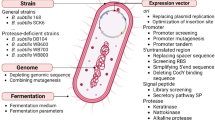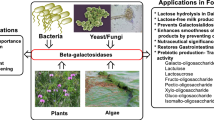Abstract
DNA shuffling was carried out with two chitosanase genes belonging to glycoside hydrolase family eight from Bacillus cereus KNUC51 and B. cereus KNUC55. The shuffled products, YM18 and YM20, which showed higher activity than the parents at 40°C, were selected for further studies. The 50 kDa chitosanases were purified using affinity chromatography with glutathione-Sepharose 4B. In general, the specific activity of YM18 is enhanced 250% and that of YM20 is 350% compared to the parents. YM20 exhibits a shift of the optimal pH level from 5.5 to 6.5. DNA sequence analysis revealed that YM18 and YM20 contained 2 amino acid substitutions (I13T and A87V for YM18; K66R and N352S for YM20). We presumed that these amino acid substitutions increase the specific activity and change the property of the two variants.




Similar content being viewed by others
References
Adachi W, Sakihama Y, Shimizu S et al (2004) Crystal structure of family GH-8 chitosanase with subclass II specificity from Bacillus sp. K17. J Mol Biol 343:785–795
Bertani G (1951) Studies on lysogenesis. I. The mode of phage liberation by lysogenic Escherichia coli. J Bacteriol 62:293–300
Collins T, De Vos D, Hoyoux A et al (2005) Study of the active site residues of a glycoside hydrolase family 8 xylanase. J Mol Biol 354:425–435
De Vos D, Collins T, Nerinckx W et al (2006) Oligosaccharide binding in family 8 glycosidases: crystal structures of active-site mutants of the β-1,4-xylanase pXyl from Pseudoaltermonas haloplanktis TAH3a in complex with substrate and product. Biochemistry 45:4797–4807
Dumon C, Varvak A, Wall MA et al (2008) Engineering hyperthermostability into a GH11 xylanase is mediated by subtle changes to protein structure. J Biol Chem 283:22557–22564
Gao X-A, Ju W-T, Jung W-J et al (2008) Purification and characterization of chitosanase from Bacillus cereus D-11. Carbohydr Polym 72:513–520
Imoto T, Yagishita K (1971) A simple activity measurement of lysozyme. Agric Biol Chem 35:1154–1156
Lee H-S, Jang JS, Choi S-K et al (2007) Identification and expression of GH-8 family chitosanases from several Bacillus thuringiensis subspecies. FEMS Microbiol Lett 277:133–141
Lorimer IA, Pastan I (1995) Random recombination of antibody single chain Fv sequences after fragmentation with DNaseI in the presence of Mn2+. Nucleic Acids Res 23:3067–3068
McCarthy JK, Uzelac A, Davis DF et al (2004) Improved catalytic efficiency and active site modification of 1,4-(beta)-d-glucan glucohydrolase A from Thermotoga neapolitana by directed evolution. J Biol Chem 279:11495–11502
Moore JC, Jin HM, Kuchner O et al (1997) Strategies for the in vitro evolution of protein function: enzyme evolution by random recombination of improved sequences. J Mol Biol 272:336–347
Park YM, Chang HL, Huh TL et al (2004) Molecular cloning of chitosanase gene and quantitative production of chitosan oligomer. Korean J Microbiol Biotechnol 32:16–21
Qin Y, Wei X, Song X et al (2008) Engineering endoglucanase II from Trichoderma reesei to improve the catalytic efficiency at a higher pH optimum. J Biotechnol 135:190–195
Stemmer WP (1994) Rapid evolution of a protein in vitro by DNA shuffling. Nature 370:389–391
Turunen O, Vuorio M, Fenel F et al (2002) Engineering of multiple arginines into the Ser/Thr surface of Trichoderma reesei endo-1,4-(beta)-xylanase II increases the thermotolerance and shifts the pH optimum towards alkaline pH. Protein Eng 15:141–145
Author information
Authors and Affiliations
Corresponding author
Electronic supplementary material
Below is the link to the electronic supplementary material.
Rights and permissions
About this article
Cite this article
Park, YM., Ghim, SY. Enhancement of the activity and pH-performance of chitosanase from Bacillus cereus strains by DNA shuffling. Biotechnol Lett 31, 1463–1467 (2009). https://doi.org/10.1007/s10529-009-0017-2
Received:
Revised:
Accepted:
Published:
Issue Date:
DOI: https://doi.org/10.1007/s10529-009-0017-2




